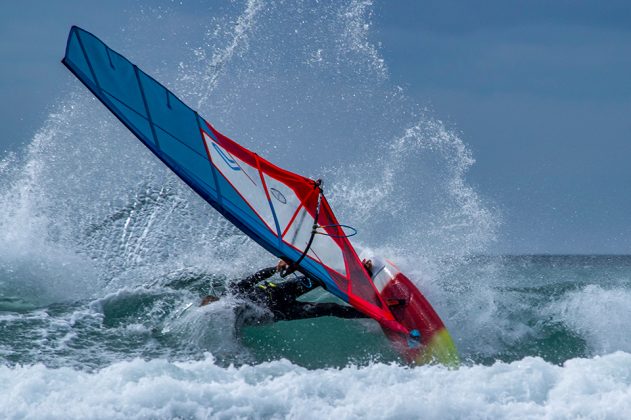PETER HART MASTERCLASS | BELIEVE TO ACHIEVE – BUT HOW?
We all dream of those golden sessions where we brim with belief and where the outcome is never in doubt. So how do we achieve those mystical sessions? If Harty had all the answers, he’d be a rich man! Nevertheless Harty, coach turned neuroscientist (for a day), speaks wisely on how to rule the self and win the mental battle.
Words Peter Hart // Photos Hart Photography & John Michelin
Originally published within the March ’19 edition.
A turning point in British sport, many believe (but cannot prove), was the 2003 Rugby World Cup, which England won in a thrilling final against Australia. It was the manner of the victory that was surprising. The teams level at seventeen all with 2 minutes of extra time remaining was a scenario tailor made for the Australians to triumph with their gritty, abrasive, never-say-die temperament. But it was the English who held their nerve and sprinted over the line the stronger. ‘There was never a moment when we didn’t think we’d win.’ Said captain Martin Johnson. Such confidence, arrogance even, was highly un-English; for we are a nation of plucky losers. But it was no fluke. It was a culture of constant achievement nurtured by coach Clive Woodward over 3 years, where no stone was left unturned in his quest for excellence. That culture seemed to infect other GB teams and individuals who were suddenly inspired to go that extra yard. The English team were good players. But man for man they were no better in terms of physicality and skill than the Australians. The difference between winning and stumbling valiantly at the last hurdle, is so often down to that intangible phenomenon – belief.
Annoying …
You hear it uttered everywhere from the football commentary box to the classroom, the ‘b’ word (belief) – and the ‘c’ word (confidence). It can be very annoying. “Be more confident Cyril!” It’s advice as useless and empty as : “don’t be afraid!” (no one chooses to be afraid, it’s a primordial response to danger); and “grow taller!”
“Be confident … believe!” Yes … nice idea … but how? Belief and confidence result from the fortuitous merging of many elements – a happy environment, skill, fitness, new kit, knowledge, good looks, wealth and … whatever. And yet we’ve all been there. That day when for reasons unknown, it all came together. Perhaps it was a serendipitous moment when your favourite track came on the radio as you approached the beach; or perhaps it was the shining sun; or being able to use your most treasured board and rig combo; or a passing complement from someone you respect – anyway for a few hours you felt liberated and empowered to perform at your best and break new ground. You truly believed. And then the next session, you were back to being your cagey, reticent, overcautious self. How …?
Powerful mind
There is no doubting the power of the mind. A Turkish weightlifter kept failing to lift 400 kg, a new world record, until his coach told him it was 370 kg, then he lifted it easily. I got a timid lady to sail a 90 litre board (impossible she said) by writing ‘120 litres’ on it. What prevents most windsurfers from progressing is not a lack of ‘how to …’ information – that’s just a device away – but instead guidance on how to deal with the ‘practice, fail, repeat,’ cycle that threatens to crush the spirit.
Resilience, grit, stubbornness, perseverance – they all sound like given character traits. To a certain extent they are – but you can acquire them and train the mind in the same way as you can train the body.
Hard
Talking to both beginner and expert about our sport – a theme often prompted by the presence of a kiteboarder who has defected – is that windsurfing is hard. I’m always at pains to point out ‘hard’ is not pejorative. It’s good. It’s why we love it … and hate it in equal measure. It’s the momentary hating that makes the loving ever more intense. Windsurfing should not attract people who want to bumble along the median line of emotion. To flourish you face a similar challenge as the elite sportsman, just further down the scale. You have to deal with adversity, failure and the nagging suspicion that you’re rubbish and should give up the unequal struggle. The mental skill of the best is being able to process, reframe, interpret and learn from negative events – and hence attack the next move with a smidge more belief.
Belief: thoughts INTERNALISED AS TRUE; constructed and shaped in life based on events we perceive as true or false.
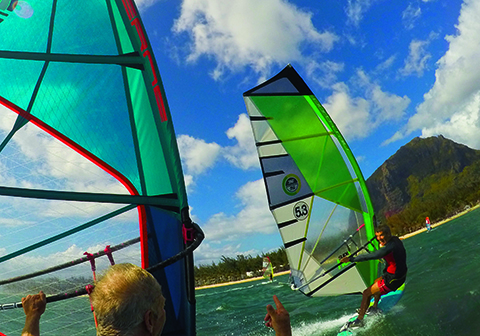
Belief and confidence come from many sources – and it’s amazing the difference when smiling is involved.
Photo Hart Photography.
Compulsory failure
There’s no easy way to say this, but to master even the relatively simple skills like getting into the straps, you have to take risks – in this case move the rig into a place, forward and upright, where it generates maximum power and might catapult you. To carve a gybe, you have to drop yourself boldly into the void before powering the rail, unaware initially if centrifugal forces will support you. To succeed, you will fail – but fail you have to.
As a coach, every now and then I stumble on someone who has rendered themselves ‘un-coachable’. It has nothing to do with their physical attributes. Often they’re technically very sound. It’s that mentally they’ve shut off the possibility of improving. It’s all too common because we are actually hard wired to play safe. It’s time to delve into a little amateur neurology.
The developing brain
The brain is ‘jerry-built’. It didn’t come preformed. It has grown and been added to over years. The limbic system formed early in human evolution and deals with the fight or flight, instinctive survival stuff. The prefrontal cortex developed later and is central to things like happiness, emotional management and performance and has doubled in size over the past 500,000 years, which in evolutionary terms is relatively recent. The sports psychologist Ian Price has a very good analogy to describe how these 2 brain parts co-exist and affect behaviour. Imagine a bungalow with a few rooms added. The main room (the limbic system) is inhabited by an emotional, instinctive, potentially aggressive sofa-dwelling bloke. Then a flatmate moves into one of the added rooms (the prefrontal cortex). The flat dweller is thoughtful, analytical, ambitious, full of new ideas.
By the door is a whiteboard on which is written all the news that comes in daily. Whoever is in charge of the house at that moment, interprets that news and ultimately the beliefs and behaviour. So if the flatmate is weak, then the sofa-dweller runs the place.
The sofa-dweller doesn’t want to do anything risky or tiring. He’s basically bone idle and just wants to watch telly and eat pizza – and he’s very negative. When the flatmate suggests a new idea, the sofa slob says it’ll never work because he’s not good/strong/brave enough etc.
Have you ever wondered why it’s easier to drop out than say, “I’m going to go for it?”
Knowing where that sudden negative thought comes from is reassuring. The next step is knowing how to deal with it – and failure in general.
Reframing the failures
Belief and behaviour are closely linked and how we deal with negative events is determined by how we explain them to ourselves.
So taking a real life example, you’re trying to get planing. But as soon as you hook in, you get hurled onto the sail. If your belief at that point is: “I’m rubbish. I took up this sport too late; I’ll never be any good,” that belief is permanent and self-fulfilling. If you cling to it, you won’t bother trying, won’t get any coaching (what’s the point?) and will malinger in ‘Average-ville.’
But that needn’t be the way. You just need to reframe that belief and behaviour. You begin by accepting that windsurfing excellence stems from effort and practice rather than innate talent; that resilience is far more important than strength and despite your late start, you can push it further than you think.
A change in that fundamental negative belief halts the limiting behaviour. Hold that thought.
It’s not the event itself – it’s how you explain it to yourself.
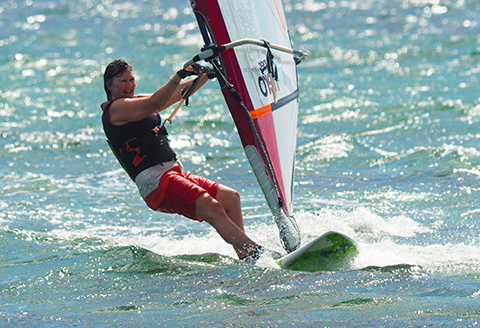
Having been a master of self-criticism, Jax now banks the victories and is positivity personified.
Photo Hart Photography.
Positivity?
“You’re much better than you think you are!” I said to Jackie after she’d screamed into the beach both feet in the straps. I wasn’t being patronising. She really was. But her reaction to every run would be a self-criticising diatribe listing everything that went wrong; whilst I would counter her by listing everything she’d done well. She admits that it’s a problem and one shared by a lot of women.
So much is written about the ‘power of positive thinking’ that it’s clichéd and potentially even harmful. Martin Seligman, a leading psychologist, makes a clear distinction between empty positivity and positive psychology. The former is just putting good labels on bad things (“I’ve had my legs amputated. Think of the money I’ll save on shoes …”) and then feeling worse about the situation. The latter is an optimistic interpretation of events based on evidence – very useful in sport.
It starts with this notion of ‘banking your wins.’ It’s not something that comes easily to those with a naturally ‘glass half empty’, ‘eeyore’ like disposition. After every session, you have to actively remember something that went right, relive it and hit the ‘save’ button.
This is the first thing I make people do who emerge from the water wearing the mask of misery, ready to vent profusely about how crap they were.
Dr Seligman talks about the A B C D E approach to coping with adversity.
A is the Adversity. You’ve just blown a gybe.
B is the Belief. You believe you’re no good.
C is the Consequence. It takes many forms ranging from the mild to the catastrophic. Your technique is corrupt; you could’ve hurt yourself and have to take time off work; it’s just an allegory for you life which is a complete mess.
D is the Disputation. Now we’re fighting back. You dispute those beliefs. No I’m not rubbish. Drawing on your bank of wins, you say: “I can do this. I’ve it done it before. I’m perfectly capable. I just need to focus on the basics; get up to speed, establish a good platform, lead with the head etc.”
E is for Energise. It’s something the pros are very good at. It’s the tennis player taking time between points to get his or her breath back, but also to refocus rather than carry blindly on in a mood of mild rage. The classic example in windsurfing is when you get smacked in the shorebreak. Don’t try and launch immediately with your heart exploding our of your chest; but retreat to dry land, reset, lift the head, widen your view re-establish the aims, re-energise and then finally with breathing and emotion under control, go again.
“There’s nothing good or bad – but thinking makes it so …” Shakespeare
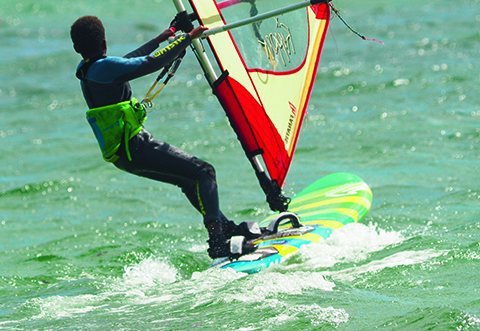
When it comes to belief, we can learn a lot from kids who tumble and splash with no fear of consequence or self-recrimination. To wit local boy Zion from Mauritius. Photo Hart Photography.
Mindfulness
It’s the current buzzword amongst hipsters and everyone in search of a little calm and meaning in their stressful lives. I hesitate to mention it here because it’s a bit ‘wooo wooo’, but it is SO relevant to sporting performance and is key to dealing with failure.
It fundamentally describes ‘living in the present’. When Roger Federer beats Nadal in a thrilling 5 setter, he’s lost nearly 50% off the points. That’s a lot of failure to deal with – but he’s obviously quite good at it. Every lost point is immediately put in the bin and he focuses 100% on the next shot. How many times have we seen a huge momentum swing involving lesser players following a duff shot or a bad line call, as the aggrieved chunters on about how the world is against them. Many treasure their windsurfing hours primarily because the sport is so all consuming that there is no brain space left for extraneous thoughts and they are forced to live in the moment – just to stay upright.
However, when learning a new skill, the mind can wander. Learning to loop is an extreme example. The majority either reminisce painfully about the last attempt, or project into the near future and imagine all manner of worst-case scenarios. It happens at all levels. There are mental techniques to keep you in the present. One is a constant dialogue – a live commentary describing exactly what you’re doing. Another is to focus on the role of a body part. The head is a good one, but it could be feet, or hips or hands – whatever. The mind is a directionless toddler and you need to keep it distracted. Above all you have to believe that improvement is possible …
Fixed versus growth mindset
Research in the classroom revealed that an important factor in the development of children was whether they believed their intelligence was fixed or could be grown. In one test the kids were praised differently. One group were told, “you’re obviously really smart.” And the other were told “well done, it’s clear you’ve worked really hard at this.” It transpired that the latter group would persist and had the confidence to take on tougher challenges. They had a growth mindset. Whereas the ‘smart’ group feared tests or challenges which might expose them as not being smart. That’s a fixed mindset.
A fixed mindset is a real issue with many windsurfers who claim to be stuck on a plateau. But the plateau is of their own making. They are comfortable at that level. They have a competence status. They know that the next level will involve entering the dark and dirty zone of trial and error, which will threaten that status. Compare that to the kid freestyler crashing and burning 104 times in a session, laughing all the way with total mental and physical freedom and not a hint of narcissism. Now that’s a growth mindset. An essential part of improving is that nebulous and also potentially harmful pursuit of goal setting.
It’s a new directive in all sports coaching that you praise effort not talent.
The goal setting conundrum
‘Make your dreams come true’, ‘think big’ and ‘go for your goals’ are email signature type aphorisms, which although wonderfully positive and well meaning, can also be detrimental. A kid loves his windsurfing, does their first vulcan to enormous applause and then declares they’re going to be world champion. Great. It’s a statement of passion and intent. But due to the enormity of that goal, there is huge scope for disillusionment.
The better plan is to have that dream; then park it and focus on the ‘process goals.’ This is about gathering, bit by bit, the skills that make up so many moves and ticking them off – how and where and when to move hands to sheet in and out and facilitate a rig change; initiating every move with the head rather than stare at the mast; learn to separate at the waist so you can sail comfortably switch foot; sail clew first and back-winded so much that it almost feels normal.
This is especially important at improver level.
In my experience with coaching intermediates, unrealistic goal setting is a universal issue – targeting a move which looks great without grasping what’s really involved. Belief is the title of this piece; and to succeed at something you have to believe you can do it, which is unlikely if you have none of the requisite tools. You want to carve gybe. Can you plane? Good. Are you happy bearing away at speed onto a broad reach in the straps fully powered? No? Ok that’s where we need to start. Without that acceleration and speed, nothing good will happen. So, in the first session, bear away 10° and then hold that line for 4 seconds before sheeting out and heading up – baby steps, small building blocks towards an achievable end.
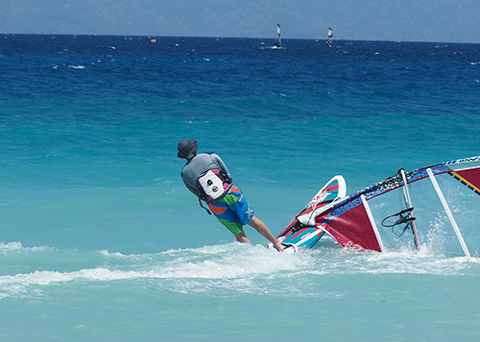
It could either be one of those catastrophising : “I’m rubbish/took it up too late/will never improve.” moments. Or “I’ve never been so committed to the inside of the turn – next time I must remember to take the rig with me…”. It’s up to you! Photo Hart Photography.
INSPIRATION
And finally in this foray into our psyches, we must never rule out the influence of our fellow humans when it comes to believing and achieving. In his book, ‘The Captain Class’, Sam Walker studies the most successful teams of all time in a wide range of sports to see what, if any, is the common factor. Is it the talent, the number of superstars, the coach, unlimited funds? None of those as it turned out. It was the leader/captain. In all cases it was a man or woman of few words, never the best talent, who was humble and led 100% by example, and who everyone would follow.
A typical and rather gruesome example was of legendary NZ rugby captain Wayne Shelford in the 80s. The French players kicked the crap out of him. He staggered into the dressing room at the end of the game almost unconscious, removed his shorts to reveal a ripped scrotum and a testicle swinging free of its normal resting place. Now as we chaps will testify, at the merest hint of any harm to that sensitive area, we to a man lie down and summon the air ambulance. So to have played on in such a state without complaint was a feat of ridiculous courage and resilience. The effect on the team was: “Well if that’s what the skip expects of us, we’d better take it up a level.” That team continued almost unbeaten for the next 3 years.
The most inspiring moments on my clinics occur, happily not when a gritty character carries bravely on with a vital organ flapping in the breeze – but when someone witnesses a peer they like and relate to, achieving their goal. The belief then pours out of them in a “if they can do it, so can I” sort of way.
So to sum it all up …
Set small, realistic goals.
Bank all your wins.
Suck the positive out of every attempt, and most important of all …
Turn a deaf ear to the miserable mumblings of the sofa dweller!
In the next issue Harty returns to a more ‘teccy’ theme, as he looks at that most useful of moves – the pivot, a.k.a. flare gybe. Check www.peter-hart.com for news of his legendary clinics.



